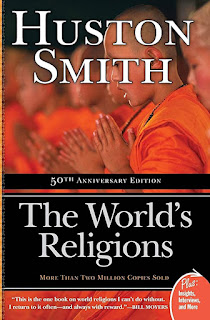 |
| Paperback cover of the 50th anniversary edition of The World's Religions, by Huston Smith, 2009. |
 |
| Author, scholar, and professor Huston Smith, 1919-2016. |
The World’s Religions, by Huston Smith, was first published in 1958, as The Religions of Man. It’s been updated several times since then, most recently in 2009 for a 50th anniversary edition. The book presents an overview of the major world religions. Smith states in the Introduction that he is not able to present a total picture of all the religions he is writing about, so instead he has chosen to focus on the best parts of each religion. As Smith writes, “Probably as much bad music as good has been composed in the course of human history, but we do not expect courses in music appreciation to give it equal attention.” (p.4) Smith has not set out to write a book that chronicles the entire history of these religions, but rather an introduction to the beliefs of those religions.
The religions that Smith covers in the book are, in order: Hinduism, Buddhism, Confucianism, Taoism, Islam, Judaism, Christianity, and a brief chapter on the religions of indigenous peoples. I never took a religion class during high school or college, so I was hoping this book would fill some of the gaps in my knowledge, and I found The World’s Religions to be quite an interesting read.
I found the chapters on the Eastern religions Hinduism, Buddhism, Confucianism, and Taoism, more interesting than the chapters on Islam, Judaism, and Christianity, but that’s probably because I came into the book with less prior knowledge about the Eastern religions. I found many of the tenets of the Eastern religions appealing, such as Hinduism’s “conviction that the various major religions are alternate paths to the same goal. To claim salvation as the monopoly of any one religion is like claiming that God can be found in this room but not the next, in this attire but not another.” (p.73)
I was also struck by Smith’s explanation of how different Buddhism is from most other major religions. Smith identifies six aspects of religion that “surface so regularly as to suggest that their seeds are in the human makeup.” (p.92) These six aspects are “authority, ritual, speculation, tradition, grace, and mystery.” (p.93) Smith then demonstrates how little of these six aspects Buddhism has—at least in Buddhism as originally practiced by the Buddha. It’s really fascinating to imagine a religion taking hold with so few of these aspects in place.
I also really liked the idea from Confucianism that life “would beckon as a never-ending project of self-cultivation toward the end of becoming more fully human. The good man or woman in the Confucian scheme is the one who is always trying to become better.” (p.180) That’s a worthy goal for all of us.
If you’re interested in learning more about the different religions, I would highly recommend The World’s Religions, as it will leave the reader with much to reflect upon.
No comments:
Post a Comment